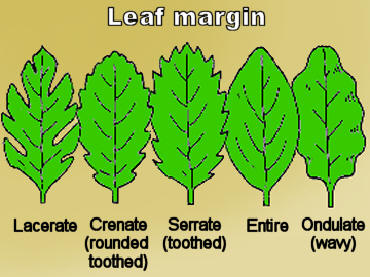| |
|
|
| |
The leaf
margin is the boundary area
extending along the edge of the leaf. There are lots of different types
of leaf margins that are important for
plant identification |
|
| |
|
|
The basic types of margins are:

Entire: having
a smooth edge with neither teeth nor lobes.
 Toothed
: having a saw like
margin with small tooth that can vary in size
(from very small to medium), in
sharpness (from needle-like to soft) and in shape (from rounded to
points). Toothed
: having a saw like
margin with small tooth that can vary in size
(from very small to medium), in
sharpness (from needle-like to soft) and in shape (from rounded to
points).

Lobed:
having some type of indentation toward the
midrib that can vary in
profundity and shape
(rounded or pointed) and the incisions (sinus) go less
than halfway to the midrib.

Parted
(or cleft):
having some type of indentation toward the
midrib that can vary in
profundity and shape (rounded or pointed) and the incisions (sinus) go
more than halfway to the
midrib.
Margins can also be a combination of toothed,
lobed, parted and smooth.
TERMS DEALING
WITH LEAF MARGINS:
-
Broadly crenate - intermediate between undulate and sinuate
-
Crenate - with low rounded or blunt teeth
-
Corrugate -
describe the loose wrinkles along a margin, but on a smaller idea than
undulated would imply.
-
Crenulate - with small, low rounded or blunt teeth
-
Entire -
no indentations, lobes, or teeth -
smooth
-
Dentate -
Sharp marginal teeth point outward.
-
Doubly serrate - with both small and larger serrations,
twice serrated.
-
Serrate - marginal teeth pointing toward the
leaf apex
(saw-like)
-
Incised -
-
Serrulate - small, marginal teeth pointing toward the blade apex
-
Sinuate - deeply wavy margin
towards the middle of the leaf
-
Spinose-dentate - as above with the teeth point-tiped
-
Undulate - wavy,
curling from the front to the back of the leaf,
but on a
larger idea than corrugated
would imply.
-
Lacerate
-
Ciliate-
Hair-like edge

|